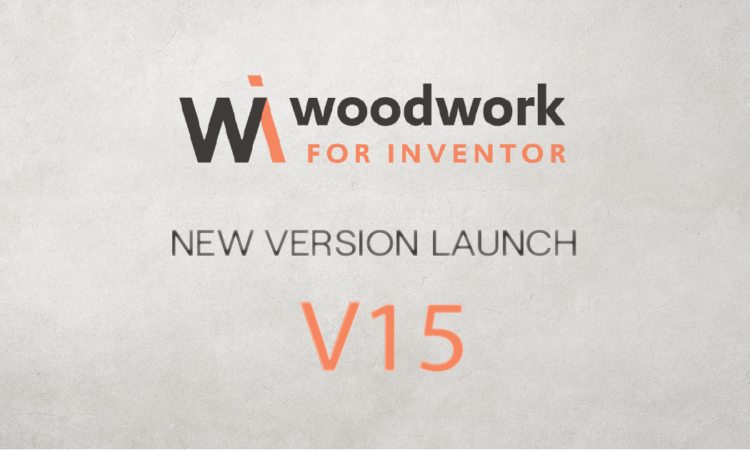What’s New in Woodwork for Inventor V15
We are excited to announce the release of Woodwork for Inventor V15! This latest version introduces a range of powerful new features and enhancements designed to elevate your woodworking design and manufacturing processes.
In this post, we’ll dive into the key improvements and new capabilities of V15, such as advanced CAM milling styles, enhanced AutoPlot features, a new BOM App, and much more. To provide a comprehensive overview, we have also included a detailed video that showcases these exciting updates in action.
Read on to discover what’s new in Woodwork for Inventor V15 and how these innovations can benefit your projects!
Improvement: Skeleton Design
Skeleton Design is extended with functions that allow the model body to be generated from curved surfaces as well.
Improvement: Design – Oversize Control
The dialogue window is supplemented with information about the material of the selected part, the size of the part itself, and the size of the workpiece. This allows the user to obtain information that could only be seen when the BOM generator was started.
Improvement: Design – Smart Hardware
The parameters generated by the connection of Smart Hardware have been supplemented with a new parameter, “Depth,” which reflects the actual depth of the connection, not the thickness of the nestled board to be connected. Previously misbehaving Smart Hardware components in Dado-type joints can now be set up to work correctly.
Improvement: Component Database
A component database accompanies the installation of Woodwork for Inventor. Revised Data Smart Hardware components. The operation logic of many components has been corrected. A new component, “Dowel,” has been introduced. Revised drawer iBox components, fixed operation logic.
Improvement: Material Replacement
The Material Replacement command now groups materials by dimension based on the accuracy specified in Woodwork for Inventor Design Settings instead of the system’s internal calculation accuracy. In this way, the user can adjust the accuracy with which the Material Replacement material grouping works.
New Feature: AutoPlot
- The user can order the AutoPlot template to generate an image of the plot, which can be saved to disk or saved to the component file itself. The image saved in the file can be output in various reports of the BOM generator with the help of the keyword.
- The user can set an option in the AutoPlot template that allows the generation of exportable files (such as PDF, DWF, etc.) during plot generation but deletes IDW files. This reduces the amount of duplicated information needed to manufacture the product.
- Added ability to export/import AutoPlot settings from one drawing file to another.
- It is now possible to order the automatic arrangement of the dimensions of the holes in the chain style.
- It is now possible to display hole dimensions that show the coordinates of vertically drilled holes on different sides of the part projection than dimensions that show the coordinates of horizontally drilled holes.
- It is now possible to run AutoPlot commands (Dimensioning, Place Hole Indexes, Place Hole Table) separately on a user drawing that was generated outside of the AutoPlot command.
Improvement: AutoPlot
- The mechanism of how the hole indices are placed in the projection of the part during AutoPlot drawing generation has been improved.
- The sketch of the part surrounding box (dimension) is now anchored to the projection of the part in the drawing and therefore cannot be moved accidentally.
New Feature: BOM Generation
- The old Woodwork for Inventor BOM generator has been replaced by a new BOM generator (BOM App). It has a much wider range of possibilities to view data. In addition, it is possible to create your own add-ons that can process the BOM information aggregated by Woodwork for Inventor. This can be particularly useful for those who want to seamlessly integrate Woodwork for Inventor information with other IT systems. For those who want to continue working with the old version of the BOM generator, in this version of Woodwork for Inventor, you will still be able to switch to the old version by changing the options in Design Settings.
- A new keyword has been introduced that allows you to output to the specification a picture written to a part during AutoPlot operation.
New Feature: iBox Insert, Smart Hardware Attachment
- The iBox Insert, and Smart Hardware attachment commands provide a mechanism that allows the user to create small applets that control new filenames and iProperty values when copying or renaming components. In this way, it is possible to release your own components naming rules.
New Feature: Assembly Copier
- Starting with this version of Woodwork for Inventor, Assembly Copier is distributed as a separate product available for purchase in the Autodesk App Store.
New Feature: CAM
- A milling style mechanism has been introduced to combine big diameter tool rough contour milling with rest contour machining with a smaller diameter tool in one operation. It is also possible to specify in the milling style the cut-into of the contour with two tools rotating in different directions in case the banded edge of the part is being cut into.
Improvement: CAM
- The Saw Cutting operation responds to Pre-Mill allowance settings.
- Pocket Operation: Now in the pocket operation, the Lead In and Lead Out type and size parameters can be set for the finishing contour.
New Feature: Shape Nesting
- An option has been introduced to start printing labels for an entire sheet of cutting material in one operation.
- When setting the Nesting style of machining for a material in the Material Editor, it is now possible to choose where the nesting start point is placed. It can be set in the middle of the longest element of the contour or the corner vertex of the contour.
Improvement: Shape Nesting
- The criterion that defines the size of the part to be fixed on the sheet by Onion Skin or Bridge has been modified. Now the user can define this criterion by specifying the maximum possible length and/or width of the part.
- It is now possible to print part labels in a single operation, for a pocket sheet of raw material.
- Introduced a new nesting contour automatic calculation algorithm. It is much more reliable, coping with the nesting contour search in the presence of slanted edges of the part, various side tenons, etc. However, this algorithm requires much more time for calculations, which causes dissatisfaction among users. For this reason, a compromise was taken. In the Material Editor, when setting Nesting processing styles for a material, you can choose how the system calculates the Shape Nesting contour. There are three options available:
- Auto – the old fast contour finding algorithm is enabled first. Then it is checked whether it was found successfully. If not, then a detailed contour search algorithm is started.
- Fast – Nesting contour search remains only with the old, fast algorithm.
- Detailed – Nesting contour search based on a new algorithm.
- By default, the system works in Auto mode.


